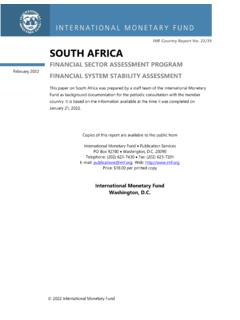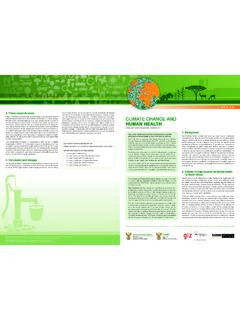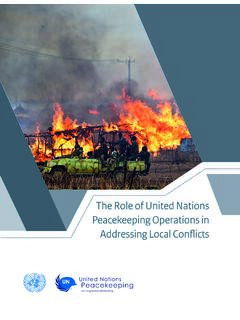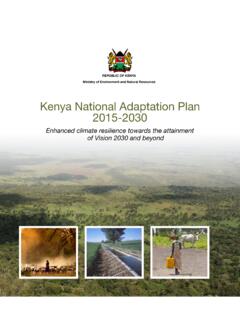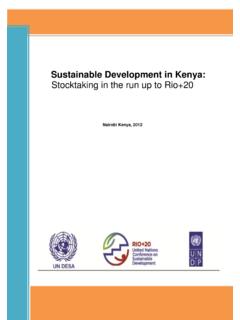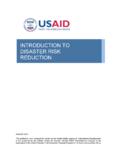Transcription of SUB-SAHARAN AFRICA MULTI-ANNUAL INDICATIVE …
1 SUB-SAHARAN AFRICA . MULTI-ANNUAL INDICATIVE PROGRAMME 2021-2027. 1. The overall lines of the EU international cooperation in SUB-SAHARAN AFRICA Basis for programming New prospects and challenges are emerging in AFRICA resulting from economic, political social, technological, climate and environmental changes, health crises as well as evolving security threats. The European Union (EU), in reinforcing its geopolitical profile, calls for a strategic partnership with AFRICA to tackle together these emerging challenges and to pursue common priorities and interests. It represents a renewed partnership encompassing core priorities to best support the process of sustainable and inclusive recovery in SUB-SAHARAN AFRICA . The policy framework for the EU's development cooperation was laid out in the European Consensus on Development, which sets the political vision underlying the financial proposals of the MULTI-ANNUAL Financial Framework (2021-2027).
2 The core objective remains the eradication of poverty and the implementation of the Sustainable Development Goals (SDGs) of the United Nations' (UN) 2030. Agenda. In that vein, the EU will continue to tackle challenges related to human development, inclusive and sustainable growth, climate change , environmental degradation, migration and mobility, as well as promote governance, democracy and human rights. The objectives of the MULTI-ANNUAL INDICATIVE Programme for SUB-SAHARAN AFRICA (regional MIP) are well aligned with the SDGs and the main components of the UN's 2030 agenda. The COVID-19 pandemic has exposed several global challenges and new important political priorities have emerged in 2020, as expressed in the Joint Communication on the global EU response to COVID-191 and the Communication establishing a European Health Union2. The political and policy objectives are captured in the five partnerships proposed in the Joint Communication Towards a comprehensive strategy with AFRICA 3, as well as in the subsequent Council conclusions of 30 June 20204 that emphasise the need (i) to deepen the partnership to promote, adapt, and, where necessary, reform the multilateral order; (ii) to promote democracy, good governance, the rule of law, human rights, gender equality and inclusive and participative societies; (iii) to step up our efforts to ensure peace, security and stability; (iv) to promote mutually beneficial trade and investment.
3 (v) to keep investing in people and empowering them, including through ensuring access to inclusive and equitable quality education for all, in particular young people, women and girls; (vi) to support a green transition; (vii) to pursue a vision of an inclusive digital economy and society; (viii) to strengthen the human dimension of the partnership through a people-centred approach; and (ix) to develop a balanced, coherent and comprehensive approach to migration and mobility. Moreover, the European Council conclusions of 16 October 20205 further commit to strengthening EU support to health systems in AFRICA . 1. JOIN(2020) 11 final of 2. COM(2020) 724 final of 3 JOIN(2020)4 of : (i) a partnership for green transition and energy access; (ii) a partnership for digital transformation;. (iii) a partnership for sustainable growth and jobs; (iv) a partnership for peace & governance, and (v) a partnership on migration and mobility.
4 4. AFRICA Council conclusions 9265/20 of These Council conclusions have been further developed at sub- regional level with the adoption of Council conclusions on the EU's Integrated Strategy in the Sahel (7723/21 of ). and the Horn of AFRICA (8135/21 of ) that outline EU's priorities in both sub-regions. 5. European Council conclusions EUCO 15/20 of 1. The african , Caribbean and Pacific states and the EU have negotiated a successor to the Cotonou Agreement, which contains a specific AFRICA Protocol. Once it enters into force, it will provide a legally binding framework for cooperation between the EU and the SUB-SAHARAN AFRICA countries on inclusive, sustainable economic growth and development', human and social development', environment, natural resource management and climate change ', peace and security', human rights, democracy and governance' as well as migration and mobility'.
5 The priorities negotiated in the Cotonou successor agreement as well as the EU's policy documents are fully in line with AFRICA 's Agenda 20636 ensuring a mutually beneficial partnership and contributing towards attaining the UN SDGs 2030, reducing poverty and addressing inequalities by building democratic inclusive and sustainable societies. In light of the EU's unique history of successful regional integration, the EU brings a very distinctive added value to the african integration stories that are being written: sharing this experience is an important part of the continental/regional programming action. The basis for programming is a set of policy or strategic documents above detailed. The MULTI-ANNUAL INDICATIVE Programme for SUB-SAHARAN AFRICA (regional MIP) covers the EU's partnership with Sub- Saharan AFRICA in a comprehensive manner and reflects the guiding principles of the Neighbourhood, Development and International Cooperation Instrument-Global Europe (NDICI-Global Europe) of simplification , subsidiarity , geographisation and policy first in our interaction with key stakeholders.
6 The complementarity of the NDICI-Global Europe's thematic components needs to be ensured with the geographic programmes (geographisation principle). Actions are envisaged at three levels: country, multi-country/(sub-)regional/trans-regio nal, and continental ( whole of AFRICA . approach).7 Actions will be implemented in line with the Team Europe approach (see section ). through close consultations between the European Commission and EU Member States. In defining the regional programming priorities, the country dimension constitutes the departure point. In other words, the regional MIP's priorities are anchored into priorities established in the country MIPs, which in turn are further complemented with actions articulated at the regional/continental level, as appropriate. All actions funded under the regional MIP, whether implemented at country level or at regional/continental level, will demonstrate a clear added-value to address an issue from a regional perspective (subsidiarity principle).
7 Specific geographic approaches that call for a common multi-sectoral response will be developed for specific (sub-) regions, including North AFRICA , as and if appropriate, in articulation with Neighbourhood South regional programming. This could, for instance, include support to integrated cross-border programmes around the Sudan/South Sudan border, an integrated response to instability in G5 Sahel and around Lake Chad, including the Accra Initiative; an integrated programme for the Blue Nile, an integrated programme for the Red Sea or cover areas such as the Horn of AFRICA , the Great Lakes, the Gulf of Guinea, the Western Indian Ocean. Along the same line, initiatives bringing together countries with similar cultural and linguistic identities, as well as shared government structures and institutions, such as the PALOP-TL (Pa ses Africanos de L ngua Oficial Portuguesa e Timor Leste).
8 african Portuguese speaking countries and East Timor) grouping, should be further developed also as a way to maintain this special political and policy dialogue. The SUB-SAHARAN african region also includes six insular states, most of them being small island developing states (SIDS). These SIDS have different degrees of economic development but they are all prone to climate change consequences and 6. african Union: Agenda 2063 The AFRICA We Want , Final Edition, April 2015. 7. Actions at multi-country level are implemented in two or more countries which can, but do not necessarily belong to the same (sub-)regional group of countries. Actions at regional level cover all countries of SUB-SAHARAN AFRICA . Actions at sub- regional level cover groups of countries, which cooperate within an institutional or policy framework or mandate (either as Regional Economic Communities or other types of regional organisations), or which are part of a broadly defined geographic space ( Sahel, Horn of AFRICA , Gulf of Guinea, West AFRICA , East AFRICA , Central AFRICA , Southern AFRICA , Indian Ocean, etc.
9 Actions at continental level cover all countries of SUB-SAHARAN AFRICA and Northern AFRICA . Actions at trans-regional level cover any number of countries in SUB-SAHARAN AFRICA and any number of countries in other neighbouring regions ( Northern AFRICA , the Gulf region, etc.). 2. share the common high vulnerability to environmental disasters due to their insular status. The regional MIP will therefore give due consideration to the specificity of SIDS. The regional MIP also caters for the AFRICA continental dimension and will contribute substantially to the supporting the priorities of the EU-AU summit of 2022. To this end, it will contribute to addressing a number of continental priorities, for instance with regard to the african Continental Free Trade Area (AfCFTA) as a game changer to increase intra-continental trade and continue boosting economic and trading partnership with Europe.
10 In addition, while alignment with the priorities of the african Union (AU) and the regional organisations in AFRICA will continue to be ensured, including through a stepped up policy dialogue, the priorities and envelopes in this regional MIP do not follow an institutional logic. The partnership with regional organisations and the AU will be guided by joint objectives and will emphasise the added value of joint cooperation in a number of priority areas (policy first principle). Where a trans-regional action includes the territories or outermost regions of a Member State, the relevant services of the Commission shall discuss the implementing modalities and specific interventions for implementation, pursuant to the NDICI-Global Europe regulation (article 43), the Overseas Association Decision (articles 72(c) and 82(4)) and the European Territorial Cooperation (article 55), which will be reflected as appropriate in the relevant Annual Action Plans/measures and within the Interreg programme(s).










